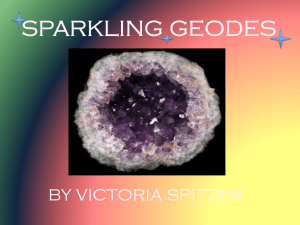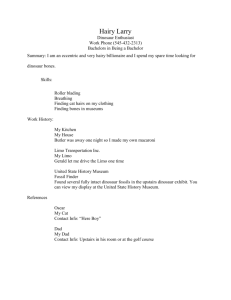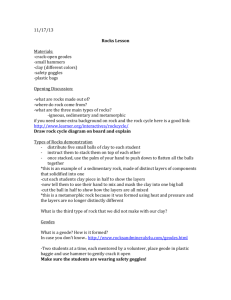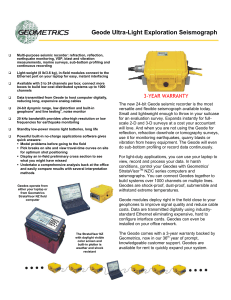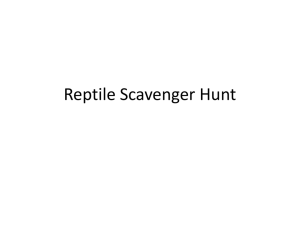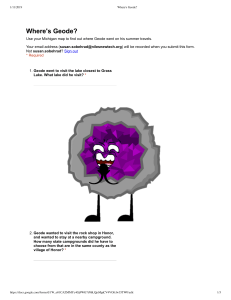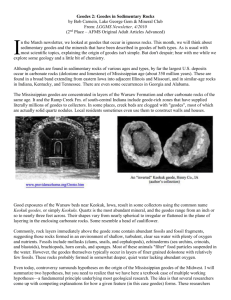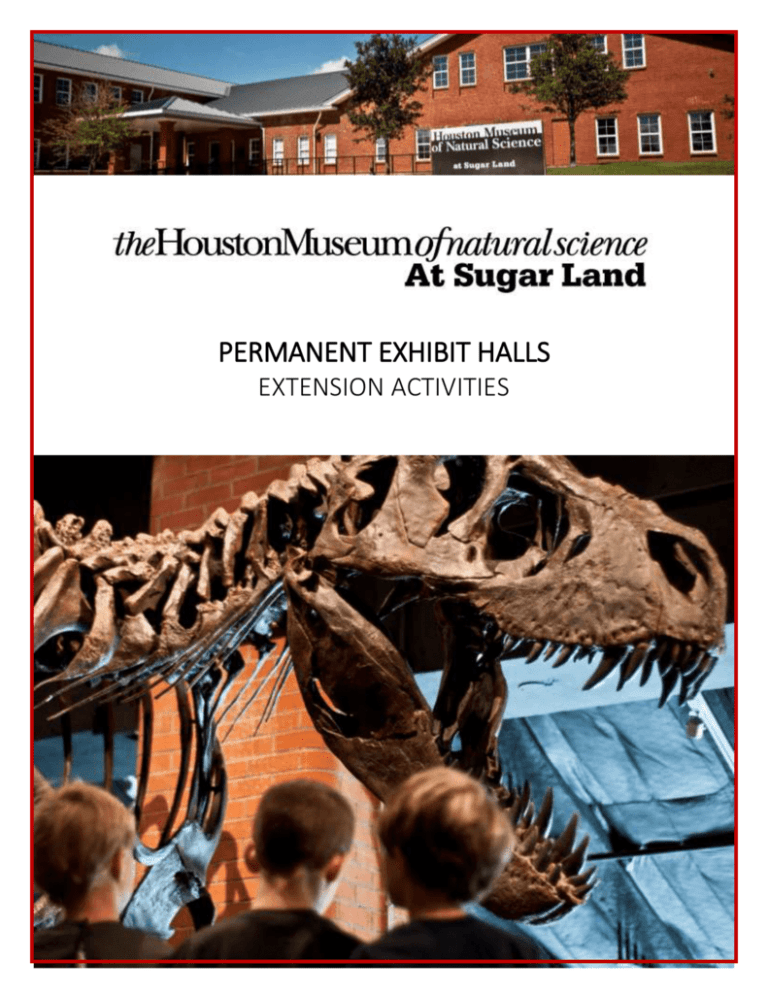
PERMANENT EXHIBIT HALLS
EXTENSION ACTIVITIES
Sugar Land Extension Activities
Dear Educator,
Thank you for downloading the free, online curriculum available at HMNS! We’re thrilled to see that
you are including the world-renowned Houston Museum of Natural Science in your educational
toolkit.
Here at HMNS our mission has always been to provide exemplary educational opportunities for the
community. Providing educators like you with free, fully editable curriculum is just one of many ways
we are fulfilling that mission.
Thank you again, and we hope you enjoyed your field trip to HMNS at Sugar Land!
Best,
The HMNS Staff
How to use this guide:
1. Feel free to use the .DOC version of this file to edit the questions as needed to suit your
student group.
2. This Extension Activity Packet is specifically for the Houston Museum of Natural Science at
Sugar Land. To access curriculum for other Museum locations, please see our website at
hmns.org/curriculum.
3. This Extension Activity Packet is largely based on the corresponding Knowledge Hunt,
although students do not need to have completed the Knowledge Hunt to use the activities
in this packet.
Please direct any and all questions to curriculum@hmns.org
6/15/2016
Page 2
Developed by theHoustonMuseumofnaturalscience. All rights reserved
Generously supported by Phillips 66
Sugar Land Extension Activities
Hall of Earth Science
(1st Floor)
Geodes Worldwide
Divide the class into several small groups. Assign each group a map of different countries from
around the world. Ask the groups to predict where they think they might find geodes on their maps.
They should shade in the areas using their map pencils. Next, tell each group to research the areas
they have been assigned to discover if their predictions have been correct. They should choose a
new color to shade in the area where geodes can be found. Ask the groups to find out, during their
research, why each area is a good or bad place to find geodes. Each group should be prepared to
explain what they have learned.
State Geodes
Using the internet, instruct the students to discover which states in the United States have an
abundance of geodes. As a class, use a large U.S. map to color in the states where geodes are
present. Draw a star on each state whose State Rock is a geode. Ask the students to hypothesize
why geodes are more plentiful in some states than others.
Rock Wall
Use any common tangram shape and make a copy for each student. Give the students enough time
to color the tangram shapes and cut them out. Using a paper plate as the “shell” of your geode,
instruct the students to arrange their cut shapes in a way that they “pop” out of the shell, i.e., a
three dimensional figure. They should glue their pieces to the plate to complete their geode. Ask
the students to explain which mineral they have chosen to be the “filling” of their geode.
(*Reminder: The type of mineral deposit built up in a geode determines the color of the crystalline
structure inside.)
Geodes and Geometry
The students saw a wide variety of large geodes when they visited the Museum. Ask the students to
draw an outline of their favorite geode from the Museum. Instruct the students that they should fill
in the shape of the geode with as many geometric shapes as will fill the space. Choose one geode
facet and draw it on a sheet of paper (a triangle, square, rectangle, etc.). Make up your own
dimensions for the shape. Using your chosen values, find the perimeter and area of your shape.
Show your work.
6/15/2016
Page 3
Developed by theHoustonMuseumofnaturalscience. All rights reserved
Generously supported by Phillips 66
Sugar Land Extension Activities
Hall of Life Science
(1st Floor)
I Can’t Eat THAT with This Mouth!
Find pictures of an Alligator Snapping Turtle and a Loggerhead Sea Turtle. Show them to the class so
they can compare the physical appearances. Ask the students how they think the physical
appearance of the animal is important to its diet. Remind the class that they saw the skulls of these
two animals while visiting the Museum. Explain to the class that one turtle eats meat and plants
while the other turtle eats shellfish and jellyfish. Ask the students to guess which diet belongs to
which turtle. Ask the students to refer to their Knowledge Hunt to see what the skulls looked like
and how their mouths were shaped. This should help them make an informed decision about each
turtle’s diet. Ask the students to think about other animals and their diets. They should begin to
realize that these particular adaptations, mouth shape and physical appearance, are of great
importance to all animals around the globe.
Nile Crocodile vs. Indian Gavial…The Great Debate!
While visiting the Museum, students completed a Venn diagram comparing the Nile crocodile and
the Indian Gavial. Divide the class into two groups; assigning each group either the crocodile or the
Gavial. The groups will research information about their assigned animal and have a debate about
which animal is superior. Tell the students they should use as many facts as possible in their
arguments. Be sure to lay down ground rules for your classroom debate.
6/15/2016
Page 4
Developed by theHoustonMuseumofnaturalscience. All rights reserved
Generously supported by Phillips 66
Sugar Land Extension Activities
Frogs and Toads
(1st Floor)
Home is Where You Lay Your Lilly Pad
Every living thing is found in a habitat or environment that allows it to survive and reproduce.
Remind students about all the different environments they witnessed while viewing the different
toads and frogs in the Hall of Life Science. Talk about what a Fire-bellied Toad might need to survive
and list all of the environments that it could NOT live in. Ask the students to create a frog habitat in
a classroom terrarium made out of an old fish tank. Assign the students jobs to maintain the
environment. Another choice would be to have each student create their own paper terrarium by
cutting out/drawing pictures and pasting them together on one sheet of paper or in a shoebox. Place
the terrariums around the room and ask the students to critique each ecosystem, noting if the frog
has the appropriate items it needs to live.
The Life Cycle Goes Round and Round
Ask the students to draw a typical life cycle of a frog. Next, ask them to look at their Knowledge
Hunts and explain how several frogs and toads they saw at the Museum have changed the life cycle.
(*Hint: tadpoles)
Help Me!
Instruct the students to look at their Knowledge Hunts and share the ideas they listed to help frogs in
their area. Make a list on the board of all the ideas the students have written. If possible, choose
one that the class can do together.
6/15/2016
Page 5
Developed by theHoustonMuseumofnaturalscience. All rights reserved
Generously supported by Phillips 66
Sugar Land Extension Activities
Hall of Paleontology
(2nd Floor)
Fossil-mania
Fossils are the remnants of creatures that lived long ago. The parts of creatures that were most likely
to turn into fossils were the hard parts, like shells and bones.
Fossils are created when an animal dies and its body is covered in sand or ash. After a long time in
the proper conditions, parts of its body are preserved. For example, if a volcano erupted, the ash
would cover the animals. Over time, the ash would create a layer over the bones and preserve them.
Research the steps that a dinosaur goes through to become a fossil. Create a flip book to illustrate
the steps and the conditions from an animal’s death to its fossilization.
Grid the Dig
Scientists know that dinosaurs are found in certain parts of the world for many reasons, including
recognizing specific rock formations. When parts of a dinosaur are discovered, scientists take every
precaution to protect the potential paleontological site. One such precaution includes making a grid
using rope and stakes over the top of the site. To determine where to make the grid, first, scientists
identify the bone and the dinosaur to which it belongs. Then, they measure out the grid based on
the estimated size of the identified dinosaur and the location of the bone in the skeleton.
Tell the students to pretend they are walking in an area where dinosaurs have previously been found
and they see a partially exposed bone fragment, such as a rib bone, a tail bone, jaw bone, etc. Ask
the students to create a grid map of the site where this dinosaur might be uncovered under rock or
sandstone. Then tell the students to draw the grid covering the area where the dinosaur is buried.
Students should research the size of the dinosaur for use in making their scale. On their map,
students need to include a key to show the scale of each square and a compass rose. Label the
quadrants of their grid using letters across the top and numbers down the side. Give the coordinates
identifying where the part of your dinosaur was exposed above the ground.
Meet the Press
Give the students a list of the kinds of scientists that work on a dinosaur dig. Some suggestions are
“geologist”, “paleontologist”, “paleolife artist”, “paleobotanist”, “geochemist”, “mapping expert”,
etc. After researching one of these scientists, have the students write a job description of that
scientist and tell why they are important to the dig. Next, students will present their scientist to the
class. They may dress as the scientist and carry objects that might be necessary on the dig in relation
to their scientist. Students should be prepared to field questions as if they are being interviewed by
the press.
6/15/2016
Page 6
Developed by theHoustonMuseumofnaturalscience. All rights reserved
Generously supported by Phillips 66
Sugar Land Extension Activities
Hall of Space Science
(2nd Floor)
Vocabulary:
meteorite, meteoroid, meteor, light years, emits, nebula, atmosphere
A Word in Pictures
While at the Museum, the students learned all about meteorites. Now they will learn how to
distinguish between the three commonly used words for these shooting stars. Write the words
“meteoroid”, “meteor”, and “meteorite” on the board. Ask the students to define these three words
by drawing pictures. Instruct the students that they may not use any words in their pictorial
definitions. Ask the students to present their pictures to the class and explain how and why their
pictures define each of the three terms.
Personal Nebula
Tell the students that they will be creating their own nebula. Give each student a large piece of
construction paper to use. Students may use glitter glue, paint, or colored glue to create their
nebulas. Tell the students that they need to make several drops of paint in different areas of their
paper. When they feel that they have put enough paint instruct the students to fold their paper in
half and press the two painted sides of paper together. Students should pull their paper apart slowly
and open it flat to see how their nebula has taken shape. Each person will need to name their nebula
based on its physical appearance. For example, the butterfly nebula was named as such because it
resembles a large butterfly. For more advanced students, ask them to calculate the distance from
one side of their nebula to the other in light years. They will need to use a ruler to find out how many
inches across their nebula measures. Explain to the students that they will need the following
formulas to help them solve the problem: 1in = 105 km and 1 light year = 9.5 x 1012 km
6/15/2016
Page 7
Developed by theHoustonMuseumofnaturalscience. All rights reserved
Generously supported by Phillips 66

